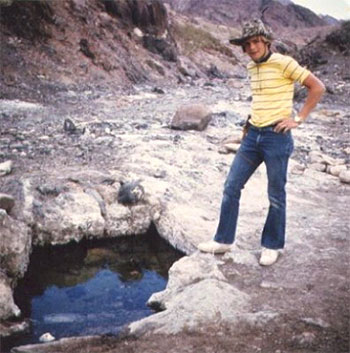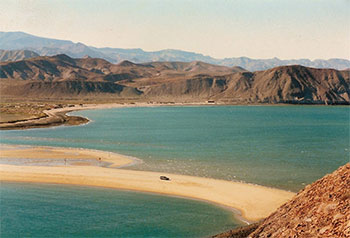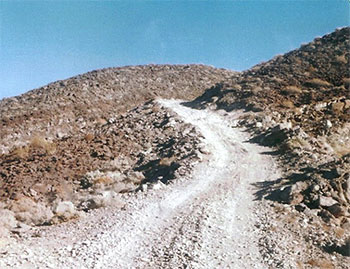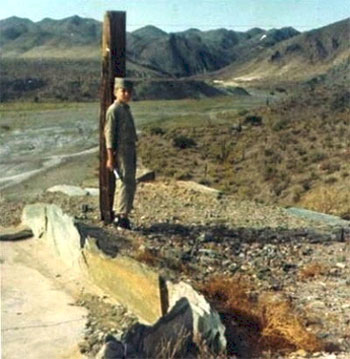 |  |
By David Kier

Just south of Okie Landing, there is a small water hole just off the road that made an interesting, brief side trip. Agua del Mezquitito was a half mile up a canyon, about 15 miles north of San Luis Gonzaga Bay. The canyon was full of quail when we first visited it in 1967. I returned in 1974 and it was unchanged, just a hole in the rock floor of the little canyon, full of water. The next time I drove in was in 2001 and it had been turned into a cattle watering corral using old tires for a fence!
The first views of Gonzaga Bay almost seem like a dream come true, considering the rough road traveled for so many hours to get there. Papa Fernandez’ Camp is on the north shore of the snug harbor next to Punta Willard, possibly named for Alexander Willard, the U.S. consul in Guaymas, Sonora from 1868 to 1891. Papa (Gorgonio) Fernandez had begun to develop the fishing camp in the late 1950’s. One of his famous clients was movie star John Wayne who helped Papa secure the valuable property. A photo of The Duke and Papa is in the restaurant at the fish camp. Papa died in 2001 at the age of 104.
An airstrip once was the primary method for American fishermen and hunters to get to Gonzaga Bay. The road was just that rough and took many more hours, sometimes days to begin fishing activities. In 1965, a film crew was camping at Papa Fernandez’. They were beginning their feature film about hunting in North America: Bighorn Sheep to Polar Bears, titled ‘The American Adventure’.

On the south side of Gonzaga Bay, a sand spit connects at low tide to an island. Near this, on a long sand beach is Alfonsina’s Resort, developed in the early 1960’s also with an airstrip. While typically still referred to as Gonzaga Bay, the larger body of water between Alfonsina’s and Punta Final at the south end of the big bay is named Ensenada de San Francisquito. The site of Punta Final Resort was originally Puerto de San Francisquito where gold ore and supplies for the miners were transferred.
Click to view the coast map from Gonzaga Bay to Bahia de los AngelesMaps show a Molino de Lacy, sometimes as a mine, very near Punta Final. This was originally called Molino de San Francisquito, operated by William Lacy and ore from nearby mines was processed here. Lacy is buried on the site where ruins of the mill can still be seen. The wagon road south from the mill site passed the Pioneer gold mine before reaching the Calamajué Valley. That route today is primarily used by motorcycles and the road to the west around the mountain became the preferred automobile route.

Las Arrastras was the site of a camp where gold ore was processed using stone grinders (‘arrastras’). Just past here was an important fork in the old road. To the right was the hand built trail to Laguna Chapala, made by Arturo Grosso and to the left was a better route south that passed the gold ore mill of Calamajué, and near to the ruins of a Jesuit mission from 1766. The road next entered a little river for several miles before climbing out of the Calamajué canyon. It eventually met up with the main Baja trans-peninsular road to La Paz, and that was the end of the ‘Gulf Route’.
Just a few miles drive south on the main Baja road is where the road east to Bahía de los Angeles branched off. The 46 mile road to the coast passed by another gold mining operation from the 1930’s called El Desengaño (‘Disappointment’) and several adobe rooms were still standing when I first passed this way in 1967. Another ore mill site was passed at Agua Amarga, some mill foundation ruins was on a small cliff by some mineral springs just north of the road.

After hours and hours of slow bumping along in the desert, a most beautiful view appears as you emerge from a canyon, the island filled ‘Bay of Angels’, Bahía de los Angeles! Here a former gold miner turned resort owner had made a runway for small planes to land and built cabins around a restaurant. He struck more gold with sportsmen than picking holes in the desert. Antero Diaz was the man, and his family-like hospitality earned him the name ‘Papa’. For the tiny village of 100 people, catching of sea turtles was the primary income. Sport fishing was highly praised by anglers who flew in or a few who drove for days to reach this beautiful bay. Baja California, a half century ago, was a very rugged but beautiful and interesting place that attracted those of us seeking adventure.